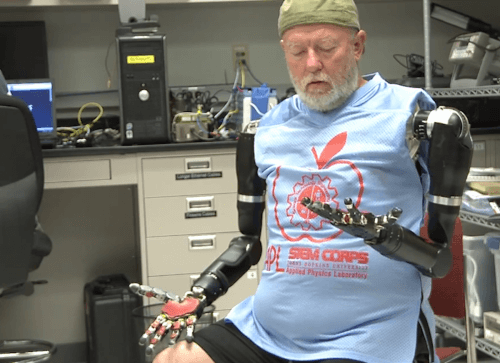For the first time, a person was able to simultaneously operate two artificial hands, which connect to his nervous system in the amputation areas, and perform delicate operations. The activation of the material hands was preceded by a long practice in simulation

For the first time, a person was able to simultaneously operate two artificial hands, which connect to his nervous system in the amputation areas, and perform delicate operations. The activation of the material hands was preceded by a long practice in simulation.
This is reported by researchers at Johns Hopkins University (See an article in Popular Science).
Leslie Baugh is not the first person to control robotic arms with his mind. Some researchers have already succeeded in providing amputees with a sense of touch, but the technique is too new and therefore has so far only been tried on one limb per patient. This is the first attempt in the world to implant two robotic arms.
To prepare his body for these devices, he underwent an operation known as "targeted muscle reinnervation". The procedure rerouted nerves that once controlled his arms to work against the artificial arms.
In the next step Bo was trained on a computer and worked with virtual models when pattern recognition software learned to match the signs from his mind to the desired movements. After that, the researchers adapted a custom mount that would attach the prostheses to his body and translate his brain commands.
Gentle actions in the bionic arm
Researchers at the University of Pittsburgh have developed an artificial hand that resembles a human hand, which is controlled by signals from the user's brain. In the video in the article you can see how a paralyzed patient manages to move her hand and perform delicate actions such as picking up small objects, using tiny electrodes implanted in her brain.
The system developed by Jennifer Collinger of the University of Pittsburgh and her colleagues implanted a network of electrodes in the left cerebral cortex of Jan Shuman, who lost control of her limbs in 2003. And she was able to move her right arm and hand. The device was connected to a computer that analyzed the electrical activities of the brain as recorded at 96 points in the network.
The researchers have developed a number of algorithms that identify the neural signals and deduce from them the required movements. It is possible that there are differences in the signals between different people, so it will be necessary to synchronize the algorithms for each person individually. (For news in New Scientist)
More on the subject on the science website
A prosthetic arm was inserted into the body and provides a sense of touch
Scientists have managed to move a bionic arm using the minds of monkeys

4 תגובות
Studies show that music contributes to brain activity
The link to the article in Popular Science is incorrect.
We have already heard several similar news in recent years that are hard to follow, but in any case it is indeed amazing and it seems that the gap between science fiction and reality is rapidly shrinking.
Stunning!
It's always impressive when science catches up with science